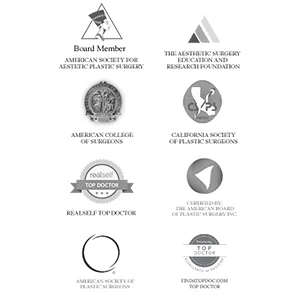Which Breast Implant Placement Provides the Most Natural-Looking Appearance?
During breast augmentation, implants can be positioned either above or below the chest wall muscle. Although both of these locations can be used to achieve successful outcomes for qualified patients, placing breast implants underneath the muscle typically provides more natural-looking results in the long run. Additional advantages of this implant position can include improved visibility for detecting breast cancer during mammograms, as well as a decreased chance of capsular contracture.1
When positioned above the muscle, the weight of breast implants (especially larger ones) often causes overlying skin tissues to stretch and thin with time. For many individuals, this may lead to noticeable shape asymmetries as well as a heightened risk of visible rippling on the skin due to a lack of soft tissue coverage. In addition, implants located in front of the muscle may produce a rounded appearance that is more likely to reveal that surgery has been performed.
Contrarily, when implants are placed below the chest wall muscle, there is generally superior short- and long-term support for the weight of each implant, greater soft tissue coverage, and a reduced risk of noticeable implant rippling. All of these phenomena can result in a more natural look and feel for the breasts.
Ultimately, there are pros and cons for both implant placement locations, and the details of each position can be thoroughly discussed during a consultation with our Laguna Beach plastic surgeon. At this time, the implant position that may be able to provide the most natural-looking results can be determined based on your unique needs and cosmetic desires.
Why Implant Placement Matters for a Natural Appearance
One of the most common goals expressed by women considering breast augmentation is achieving results that look and feel natural. While the type, shape, and size of the implant all play an important role, placement is equally critical. Submuscular (below the muscle) positioning tends to create a more gradual transition from the chest wall to the breast mound, closely mimicking the natural slope of the breast. On the other hand, subglandular (above the muscle) positioning can sometimes be appropriate for patients with ample natural breast tissue. In these cases, the breast tissue itself can provide sufficient coverage to disguise the implant edges.2 That said, subglandular implants are more likely to show visible rippling over time, particularly in thinner patients, and the “augmented” look can be more apparent.
Surgical Technique and TASPA
In addition to placement, the surgical technique used for inserting the implant can influence both aesthetics and recovery. One advanced approach offered at Dr. Mills’ practice is TASPA (Transaxillary Subpectoral Augmentation). This method involves placing the implant beneath the muscle through a small incision hidden in the natural fold of the armpit.
TASPA provides several advantages:
- Minimal visible scarring: Because the incision is under the arm, there are no scars on the breasts themselves.
- Natural-looking results: Since implants are placed beneath the chest muscle, TASPA offers the same benefits of submuscular placement—reduced rippling, better support, and softer contours.
- Quicker recovery for some patients: Many women experience less discomfort than with traditional techniques, and arm mobility is often regained relatively quickly.
Dr. Mills is renowned for pioneering the TransAxillary SubPectoral Augmentation (TASPA) technique, having performed it for more than 30 years, presented lectures worldwide on the subject, and successfully completed thousands of these procedures.
This option is not suitable for everyone, but for many individuals it represents an innovative technique that marries surgical precision with cosmetic discretion.
Other Factors That Can Influence Results
While placement is a major component, other factors contribute to whether breast augmentation looks natural:
- Implant type: Modern cohesive-gel (“gummy bear”) implants can provide a more natural look and feel than older models and are designed to hold their shape well over time.
- Implant shape and profile: Round versus anatomical (“teardrop”) implants, as well as the projection of the implant, can influence how the breast looks both in and out of clothing.
- Patient’s anatomy: Body frame, skin elasticity, and the amount of natural breast tissue are all key considerations when deciding implant placement and type.
- Surgical expertise: A board-certified plastic surgeon with experience in a variety of implant techniques can personalize the procedure to balance the patient’s goals with what will appear most natural.
Deciding What’s Best
There is no one-size-fits-all answer to the question of which implant placement provides the most natural results. For many patients – particularly those with limited breast tissue to start – submuscular placement is generally Dr. Mills’ preferred option; however, women with sufficient natural tissue may still achieve excellent outcomes with subglandular placement.
During a consultation, Dr. Mills can evaluate individual anatomy, discuss lifestyle considerations, and review the desired aesthetic outcome. Using this information, he can recommend the placement and implant type most likely to provide results that are both beautiful and natural-looking.
For more information about implant placement, or if you’d like to schedule a consultation with Dr. Mills, please contact our office today.
Medical Resources*
ScienceDirect1
Plastic Surgery Key2
Editor’s note: This blog was originally posted on November 13th, 2015



